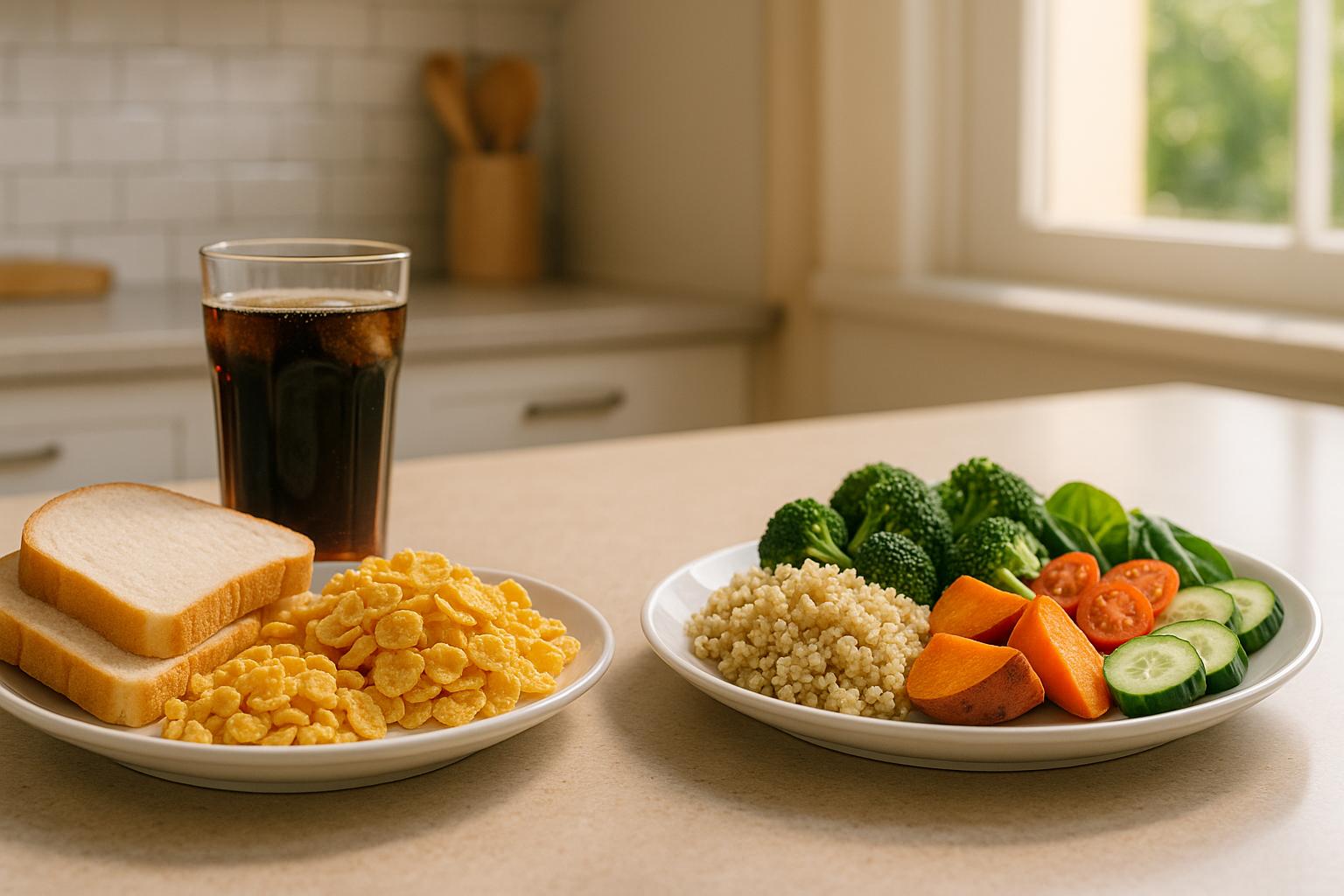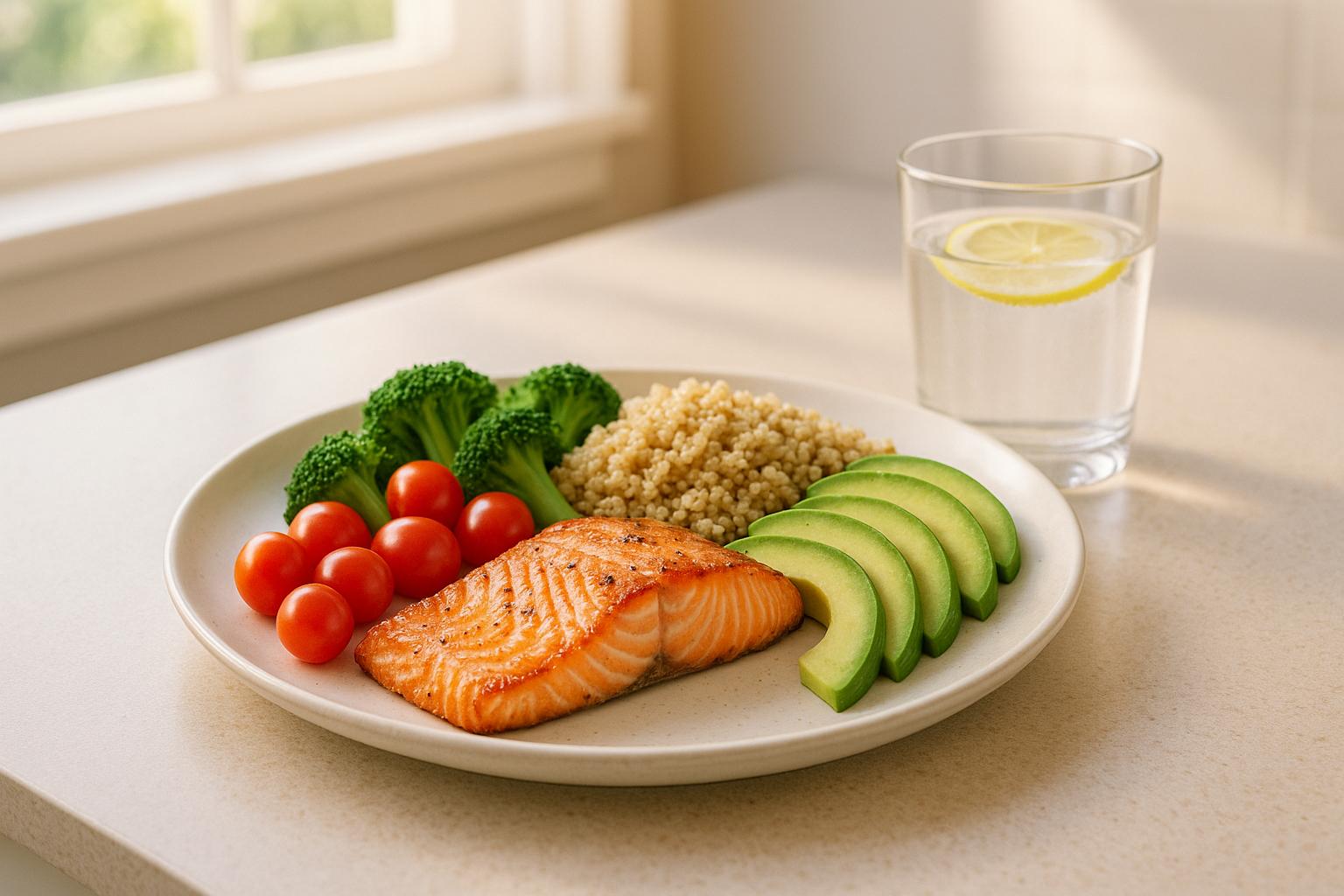High vs. Low Glycemic Carbs: What You Need to Know
How your body processes carbohydrates depends on their glycemic index (GI), which measures how quickly they raise blood sugar levels. High GI carbs (e.g., white bread, potatoes) cause rapid blood sugar spikes, while low GI carbs (e.g., oats, lentils) lead to slower, steadier glucose release. This difference impacts not just energy levels but also metabolism, fat burning, and overall health.
Key insights from the article:
- Thermogenesis (energy burned during digestion): Low GI carbs generally lead to higher post-meal energy expenditure over time compared to high GI carbs, which initially burn more but reduce fat oxidation.
- Insulin Response: High GI carbs trigger sharp insulin spikes, suppressing fat burning, while low GI carbs promote a steady insulin release.
- Fat Oxidation: Low GI carbs support better fat-burning over time, making them a better choice for weight management.
- Meal Composition Matters: Combining low GI carbs with protein and fiber can further boost energy expenditure and satiety.
Quick Takeaway: Prioritize low GI carbs like whole grains, legumes, and non-starchy vegetables for sustained energy, improved metabolism, and better long-term health. Pair them with protein and fiber for maximum benefits.
The Dietary Glycemic Index: Everything You Need to Know
How High vs. Low GI Carbohydrates Affect Your Body
The way your body processes carbohydrates - whether they're high or low on the glycemic index (GI) - plays a big role in energy balance, fat burning, and overall metabolic health. These differences stem from how quickly carbs are digested and how they influence your body's hormonal and metabolic responses.
Glucose Absorption and Insulin Response
High GI and low GI carbs behave very differently in your body. High GI foods, like a baked potato, are digested quickly, causing a rapid spike in blood sugar. On the other hand, low GI foods, such as oats, break down more slowly, leading to a steady release of glucose into the bloodstream.
This difference matters because high GI foods trigger a sharp insulin surge. Insulin helps shuttle nutrients into cells but also suppresses fat breakdown. Meanwhile, low GI foods lead to a more gradual insulin release, which supports steady energy levels and impacts how your body chooses to burn fuel after eating.
Carbohydrate and Fat Burning After Meals
The type of carbs you eat also affects what your body burns for energy after a meal. Studies show that high GI meals initially boost fat oxidation during the first 90 minutes, while low GI meals lead to higher carbohydrate oxidation in that same period.
But the longer-term effects tell a different story. Over time, high GI meals tend to reduce overall fat burning compared to low GI meals. Low GI foods, with their slower glucose release, promote a steadier rate of carbohydrate oxidation and may help delay hunger by slowing gastric emptying. This could make low GI diets helpful for appetite control and weight management.
The benefits of low GI carbohydrates go beyond just energy use. For instance, a study on individuals with type 2 diabetes found that after 24 days on a low GI diet, levels of plasminogen activator inhibitor-1 - a factor linked to blood clots and plaque formation - dropped by 53% compared to a high GI diet. This suggests that regularly choosing low GI carbs could support broader metabolic health.
These distinctions highlight how the type of carbohydrate you consume can impact your energy levels, fat burning, and even long-term health. By influencing daily energy expenditure and metabolic function, carbohydrate choice becomes a key factor in managing weight and promoting overall well-being.
This article is for informational purposes only and is not intended as medical advice. Please consult a healthcare professional before starting any new fitness or wellness routine.
Research Findings: Thermogenic Differences Between High and Low GI Carbs
Research has revealed that high and low glycemic index (GI) carbohydrates affect diet-induced thermogenesis (DIT) in intricate ways. Below are some key findings that highlight these interactions.
Energy Expenditure After Eating
Studies examining the direct impact of GI on DIT have generally found no major differences when comparing high and low GI carbs in isolation. However, the combination of foods and the context of meals can lead to noticeable variations.
For example, one study observed that a meal of salmon paired with mashed potatoes (a high GI food) resulted in a 40% higher DIT and increased carbohydrate oxidation (p = 0.002 and p = 0.03, respectively) compared to salmon served with wholegrain pasta (a low GI food). Interestingly, replacing salmon with veal eliminated this thermogenic boost, highlighting the influence of protein type on energy expenditure.
Another study demonstrated that a breakfast with both low GI and low glycemic load (GL) led to greater DIT compared to a high GI, high GL breakfast (p < 0.05). This suggests that reducing both GI and GL in meals can enhance the body’s energy burn.
How Meal Composition Affects Thermogenesis
The composition of a meal has a greater impact on thermogenesis than the GI of individual carbohydrates alone.
Protein plays a major role here, as it has a thermic effect of 20–30%, which is significantly higher than that of carbohydrates (5–15%) or fats (0–5%). This effect was evident in the salmon and mashed potato study, where the type of protein combined with carbs influenced DIT outcomes.
Carbohydrates rich in fiber also contribute to higher thermogenesis. For instance, replacing refined grains with whole grains was shown to increase metabolism by over 92 calories per day. This demonstrates how factors like food processing and fiber content can affect energy expenditure beyond just the GI of the carbs.
Meal timing and frequency also play a role. Research suggests that consuming a full meal in one sitting generates a stronger thermic effect compared to dividing the same meal into smaller portions throughout the day. Other factors, such as age, physical activity, and meal size, further influence how much energy the body burns during digestion.
To maximize energy expenditure, focusing on a diet that includes high-quality protein, fiber-rich carbohydrates, and thoughtful meal timing is more effective than concentrating solely on GI. These findings emphasize the importance of a well-rounded diet for optimizing metabolic performance.
This article is for informational purposes only and is not intended as medical advice. Please consult a healthcare professional before starting any new fitness or wellness routine.
Real-World Effects on Metabolism and Weight Management
When it comes to how glycemic index (GI) interacts with metabolism and weight management, the effects go beyond just numbers on a chart. Real-life applications paint a more detailed picture of how food choices impact energy use and overall health.
Effects on Daily Energy Expenditure
The glycemic index of carbohydrates can slightly influence how much energy your body burns daily. One study observed that individuals on a low-glycemic load diet experienced a smaller drop in resting energy expenditure compared to those on a low-fat diet - 96 calories per day versus 176 calories per day. While an 80-calorie difference might seem minor, over time, these small changes can add up, affecting weight management in meaningful ways.
Interestingly, research involving 27 population groups highlighted that GI and body mass index (BMI) often show little to no direct connection. However, the timing of carbohydrate intake after exercise can significantly impact fat oxidation. For example, choosing a lower-GI option like oatmeal instead of a high-GI food like white bread after a workout could influence how efficiently your body continues to burn fat.
Low-GI diets might only provide noticeable weight loss benefits if two conditions are met: the individual has normal glucose tolerance, and there’s a substantial difference (at least 20 GI units) between the high- and low-GI diets being compared. Beyond calorie burn, the overall quality of the carbohydrates you consume plays a critical role in supporting long-term metabolic health.
The Bigger Picture: Fiber and Nutrient Density
If you’re aiming for better metabolic health and weight management, focusing on the quality of your carbohydrates is far more impactful than just tracking their GI. Factors like fiber content, nutrient density, whole-grain consumption, and added sugar levels all make a difference.
Take rice, for instance. White rice has a high GI, while brown rice not only has a lower GI but also provides more fiber, B vitamins, and minerals. The additional fiber doesn’t just support digestion - it also helps you feel full longer and requires more energy for your body to process.
A 2019 review of 54 studies found that low-GI diets helped reduce long-term blood sugar markers, body weight, and fasting glucose levels in people with prediabetes or diabetes. However, these benefits were likely tied to overall dietary improvements rather than GI reduction alone.
Adopting a diet rich in whole grains, nuts, legumes, fruits, and non-starchy vegetables while cutting back on refined starches and sugary foods can naturally lower the glycemic load of your meals. These choices provide the fiber, protein, and nutrients that help keep your metabolism running efficiently.
For practical weight management, aim for foods that combine a moderate to low GI with high fiber and minimal processing. For example, a baked sweet potato with its skin offers slow-releasing energy, digestive benefits, and essential nutrients - all of which support a healthy metabolism.
This article is for informational purposes only and is not intended as medical advice. Please consult a healthcare professional before starting any new fitness or wellness routine.
Comparison Table: High vs. Low GI Carbs and Thermogenic Effects
The table below highlights the differences between high and low glycemic index (GI) carbohydrates, particularly focusing on their thermogenic effects and metabolic outcomes.
| Factor | High GI Carbohydrates | Low GI Carbohydrates |
|---|---|---|
| Blood Sugar Response | Quick spike followed by a rapid drop | Slow, steady increase with a gradual decline |
| Insulin Secretion | Higher glucose and insulin secretion | Lower, more steady insulin response |
| Diet-Induced Thermogenesis | 40% higher when paired with protein (e.g., salmon study) | Lower immediate thermogenic effect |
| Fat Oxidation | Reduced fat burning after meals | Increased fat burning after meals |
| Carbohydrate Oxidation | Greater carbohydrate burning post-meal | Lower carbohydrate oxidation, higher fat burning |
| Energy Pattern | Quick energy boost that fades fast | Sustained energy over time |
| Fiber Content | Generally lower (e.g., white bread, white rice) | Typically higher (e.g., whole grains, oats) |
| Satiety Duration | Short-lived fullness | Longer-lasting satiety due to higher fiber content |
This comparison aligns with earlier research connecting glycemic response to thermogenic outcomes. For instance, a 2019 study observed that diet-induced thermogenesis (DIT) was 40% higher when participants ate salmon with mashed potatoes (a high GI meal) compared to salmon with wholegrain pasta (a low GI meal). However, the metabolic benefits are more nuanced. While high GI meals like mashed potatoes can temporarily boost energy expenditure, they also lower fat oxidation. In contrast, low GI meals, such as wholegrain pasta, encourage your body to burn more stored fat.
Protein also plays a key role in thermogenesis. Its thermic effect outpaces that of carbohydrates (5–10%) and fats (0–3%). High-fiber, carbohydrate-rich meals, such as steel-cut oats with berries, can further enhance thermogenesis compared to low-fiber options like a buttered bagel, even when both are carbohydrate-based. Fiber, especially from whole grains, significantly increases metabolic activity. Ingredients like β-glucan, arabinoxylan, and inulin offer added metabolic perks beyond their GI rating.
Additionally, lowering a meal's glycemic load (GL) by choosing low GI carbs has been shown to sustain energy expenditure while promoting fat oxidation. This means that low GI foods not only preserve metabolic benefits but also optimize fat-burning potential.
It's important to note that the glycemic response to a meal depends on several factors, including macronutrient composition, fiber content, food preparation, and even the time of day. These considerations provide valuable insights into how carbohydrate choices can influence your overall metabolic efficiency.
This article is for informational purposes only and is not intended as medical advice. Please consult a healthcare professional before starting any new fitness or wellness routine.
Key Takeaways on High vs. Low GI Carbs
When it comes to understanding how high and low glycemic index (GI) carbohydrates impact thermogenesis, the relationship is more nuanced than it might seem. High GI carbs trigger a quicker post-meal blood sugar spike compared to low GI foods. However, this rapid response doesn’t necessarily lead to a sustained boost in energy expenditure. On the other hand, low GI foods provide metabolic benefits that extend well beyond the short term.
High GI foods, often more processed, tend to cause sharp blood sugar spikes while offering less fiber and fewer nutrients compared to their low GI counterparts. These differences affect more than just blood sugar levels - they also play a role in long-term metabolic health. This highlights the importance of considering nutrient density and fiber content alongside GI when evaluating food choices.
Focusing exclusively on GI for weight management can be misleading. It’s more effective to consider a food’s overall profile, including its nutrient density, fiber content, whole-grain composition, and added sugar levels. For example, a food with a GI of 28 raises blood sugar by 28% as much as pure glucose, but this number alone doesn’t reflect the food’s overall health benefits.
A practical approach involves combining an understanding of GI with smart food choices. For instance, aim to fill half your plate with fruits and vegetables, focusing on lower GI options, and reserve a quarter for starches. Limiting highly processed foods is another key strategy.
Low GI diets have shown to aid weight loss, but only under specific conditions - such as in individuals with normal glucose tolerance and when the GI difference between diets is significant (at least 20 units). Small GI variations are unlikely to result in meaningful changes.
Meal composition also plays a critical role in shaping the thermogenic response. Factors like protein content, fiber, meal timing, and preparation methods influence how your body metabolizes food. Protein, for instance, consistently enhances thermogenesis, regardless of the carbohydrate GI.
In summary, lowering the glycemic load of a meal by choosing low GI foods can increase energy expenditure while supporting fat oxidation. This combination offers long-term metabolic benefits, making low GI choices a valuable part of a balanced diet.
This article is for informational purposes only and is not intended as medical advice. Please consult a healthcare professional before starting any new fitness or wellness routine.
FAQs
What’s the difference between high and low glycemic index carbs in terms of metabolism and weight management?
How High and Low Glycemic Index Carbs Affect Your Body
The type of carbohydrates you eat - whether high or low on the glycemic index (GI) - can influence your metabolism and weight management in distinct ways.
Low-GI carbs, like whole grains and legumes, release energy gradually. This slow release helps keep blood sugar levels steady, improves how your body responds to insulin, and may lower the chances of long-term weight gain. On the other hand, high-GI carbs, such as white bread and sugary snacks, lead to quick spikes in blood sugar. These rapid changes can cause energy crashes and make you feel hungrier sooner.
While low-GI diets are often associated with better metabolic health, research suggests that their impact on long-term weight loss is relatively modest. Results can vary depending on factors like your activity level and the overall balance of your diet. That said, adding more low-GI carbs to your meals could help maintain steady energy throughout the day and support healthier weight management over time.
How do protein and fiber in a meal influence the thermogenic effects of carbohydrates?
Protein and fiber play an important role in boosting the thermogenic effects of carbohydrates by increasing the energy your body uses during digestion and metabolism. Take protein, for instance - it has a high thermic effect. About 20–30% of the calories from protein are burned during digestion, which is far more than what your body burns digesting carbs or fats. Adding protein-rich foods to your meals can help increase your overall calorie burn.
Fiber, on the other hand, works by slowing down digestion and keeping blood sugar levels steady. This helps maintain metabolic activity over a longer period. When you combine protein, fiber, and complex carbohydrates in your meals, your body has to work harder to break them down. This leads to a stronger thermogenic response and helps keep your metabolism more active.
What are the benefits of choosing low glycemic index (GI) carbs over high GI carbs for metabolism?
Choosing low glycemic index (GI) carbohydrates instead of high-GI options can have a positive impact on your metabolism. These carbs release glucose into the bloodstream at a slower pace, helping to prevent sudden insulin spikes. This steady release not only improves insulin sensitivity but also keeps your energy levels more consistent throughout the day.
Following a low-GI diet has been associated with better metabolic health overall. It can help reduce insulin resistance, lower fasting blood sugar levels, and improve cholesterol and blood pressure. These benefits, in turn, may decrease the risk of developing conditions like type 2 diabetes and heart disease. If you're aiming to enhance your metabolic health, adding more low-GI foods to your meals is a simple and effective step.












